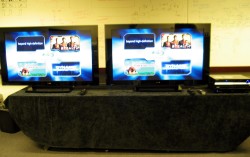Samsung will come out with a firmware update in september to fix the soft pic issue! I saw blu ray demos and i have to tell that i am dissapointed at blu-ray so far!! How did the pio. 1080p plasmas pic look like? does it worth 10grand? still waiting for next gen. 1080p displays and more improvements in blu-ray players
Samsung BD-P1000

The Variables
There wasn't any question that the image the Samsung BD-P1000 put out was inferior to the one the Toshiba HD DVD player put out. The question was why? To that end, we have to narrow down the multitude of variables.
1) The movies. At the moment we don't have the same movie on each format.
2) The codec. The first BD releases from Sony are MPEG2, for HD DVD they're VC1.
3) The players themselves.
I was able to get all three of these answered, as best they can be at the moment, at Pioneer Electronics in Long Beach.
The Setup
 Chris Walker at Pioneer set up two identical PRO-FHD1 1080p 50-inch plasmas. These were right out of the box, and reset to their factory defaults (I watched him do this). The Samsung BD-P1000 was hooked up to one, and a prototype Pioneer BDP-HD1 Blu-ray player to the other (both with HDMI). We (myself and UAV Editor Tom Norton) watched them this way for a bit, then swapped which player was on which display (just to cover all bases). We watched off-the-shelf copies of Ultraviolet, Basic Instinct 2 (don't laugh, it's unfortunately one of the better looking BD titles right now), 50 First Dates, and a trailer for Chicken Little. Across the board the Samsung looked soft and a little undersaturated.
Chris Walker at Pioneer set up two identical PRO-FHD1 1080p 50-inch plasmas. These were right out of the box, and reset to their factory defaults (I watched him do this). The Samsung BD-P1000 was hooked up to one, and a prototype Pioneer BDP-HD1 Blu-ray player to the other (both with HDMI). We (myself and UAV Editor Tom Norton) watched them this way for a bit, then swapped which player was on which display (just to cover all bases). We watched off-the-shelf copies of Ultraviolet, Basic Instinct 2 (don't laugh, it's unfortunately one of the better looking BD titles right now), 50 First Dates, and a trailer for Chicken Little. Across the board the Samsung looked soft and a little undersaturated.
Were there nothing to compare it to, the Samsung would look fine, but with HD DVD available, it just doesn't hold it's own. Even the Pioneer didn't look as good as HD DVD can with some of its titles (which isn't Pioneer's fault, but more on that later).
Then Chris showed us some clips he had compressed himself using a D5 master and MPEG2. He encoded at Blu-ray's recommended 20 megabits-per-second average with a low of 15 and a high of 35 mbps. Then he showed the same clip he had encoded at a nearly steady 35 mbps. We all agreed that maybe the 35 mbps clip looked a tiny bit more consistent, but it was so close as to not be noticeable in normal viewing. That, and it certainly wasn't a blind comparison.
Then there were a few more clips (that have to remain nameless). These were supposedly BD encoding rates, and they looked flat out amazing. This was the kind of pristine image quality and incredible detail everyone was hoping for with Blu-ray (and have now with some HD DVDs). So it doesn't appear to be a MPEG2 issue.
So why doesn't it look amazing?
Even the Pioneer lacked the pristine image quality available on some HD DVDs. To answer that side of the equation, I talked to Don Ekland, Executive VP of Advanced Technologies at Sony Pictures. I asked him something along the lines of "Warner and HD DVD had several 'reference quality' titles available at launch. How come Blu-ray doesn't have the same quality available in any of their release titles?" His response was that a decision was made to have a wide cross section of titles available at launch, to appeal to as many interests as possible.
Ok, fine. But the lack of any reference discs at launch puts the whole format in a bad light, especially since the only player available is softening the image. Sub-par transfers are painfully obvious on a format that hides nothing. He said that there will be "reference quality" titles available soon.
Ok, now what?
With the only player available putting out an image that isn't as good as it should be, and discs that don't look as good as what's available from HD DVD, the choice at the moment is clear. What isn't is the future. It's important to be clear that this isn't a technology issue, or a format issue, as far as we can tell. This is a title and hardware issue, for now. New discs are coming out every week. By Christmas, there will be at least 4 other players available for Blu-ray (and at least one more for HD DVD). Once there are some good looking titles available, and a player that doesn't soften the image, I'd be amazed if anyone could tell the difference between the formats on a visual basis.
For a few more images of the Pioneer setup, check out the Galleries.
For more info on why the Samsung is doing what it's doing, and a full review, check out the October issue of HT.
- Log in or register to post comments





















































